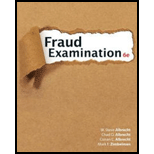
Concept explainers
To identify the type of fraud in the following cases:
Marcus pays $30 for a baseball of $70 by changing the price-tag.
Craig loses $500 by investing in a multilevel marketing scheme.
A bank employee diverts the amount from a wealthy customer’s account to his personal account. The bank was held responsible for the act of the employee.
A CEO showed profits for the year 2018, when there was a loss of $150 million. The CEO was held responsible and convicted with jail and fine.
The government lost $50 million as it was overcharged by contractor and sub-contractors in the Middle East for fictitious hours and assets.
A student accessed the school computer and changed her school grade to be accepted into graduate school.
Trending nowThis is a popular solution!

Chapter 1 Solutions
Fraud Examination
 Auditing: A Risk Based-Approach (MindTap Course L...AccountingISBN:9781337619455Author:Karla M Johnstone, Audrey A. Gramling, Larry E. RittenbergPublisher:Cengage Learning
Auditing: A Risk Based-Approach (MindTap Course L...AccountingISBN:9781337619455Author:Karla M Johnstone, Audrey A. Gramling, Larry E. RittenbergPublisher:Cengage Learning

